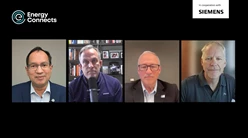Money and mindset shift needed to finance energy’s “yes-and” decade
At ADIPEC’s ‘Finance and Energy: Partnering for Energy Security and Diversification’ strategic forum, three very different corners of the capital stack agreed on one thing: the money exists to fund all forms of energy ecosystems, but what’s missing is sharper risk allocation, cleaner price signals, and a faster route from pilots to scale.
“Both AI and finance start with the same thing: data,” said Youssef Salem, CFO of ADNOC Drilling, adding, “Without validated, governed datasets, you can’t build conviction, and without conviction, you can’t unlock scale.”
“A brilliant enabler (for financing) would be a more aligned policy globally, especially on the
cost of carbon. Clarity lets us make robust investment decisions, and add energy to the system effectively.”
Roslyn Aird, Vice-President for Customer Solutions & Delivery at Shell, put policy at the centre of bankability. “A brilliant enabler (for financing) would be a more aligned policy globally, especially on the cost of carbon. Clarity lets us make robust investment decisions, and add energy to the system effectively.”
From private capital’s vantage point, James McIntyre, Co-Founder and Managing Partner at Renown Capital Partners, argued the real hurdle to financing is legacy thinking. “We don’t have a generation problem; we have a distribution and usage problem. The old mindset of ‘test, test, test’ for ten years doesn’t work anymore.”
Build the Stack to Match The Strategy
On the investment front, Salem noted that if the region is investing across hydrocarbons, low-carbon and digital efficiency, its financing must be equally diversified. “ADNOC Drilling raises across the entire capital structure—bank loans, public bonds in multiple currencies, private placements, off-balance-sheet structures, alongside equity placements and PPPs,” he said.
“Every investor has a different preference for tenor, structure, and currency. Offer that menu and you broaden the pool, lower the cost of capital, and pull foreign investment into the wider UAE economy.”
He credited ADNOC’s long-term, high-quality contract cash flows for giving ADNOC Drilling access to global bank relationships “from the US to China” and strong equity demand.
“Aligned global policy, particularly around carbon costs, would transform bankability.”
Make the Value Chain Bankable for Low-Carbon Finance
On low-carbon industry, Aird cautioned that the market is still “nascent” and the forward pricing less visible than in oil and gas. “Identify the capability gaps in the value chain and partner to fill them,” she said. “Instruments like CFDs help frame a forward price so large projects can underwrite returns.”
She also pointed to Norway’s Longship as a template where the government takes an anchor role, emitters such as cement companies contract to off-take CO2, and oil majors co-invest in transport and storage.
“It’s a value-chain construct more than a pure financeability play,” she said. As revenues clarify, she expects infrastructure funds and broader private equity to step in.
Shell is also trying to fix what Aird calls the “missing middle” between pilots and scale. The company’s decade-old corporate venture arm backs technologies it can then deploy inside
Shell, using real operations to prove business cases and compress time-to-scale. “Co-investing and then co-deploying with local partners builds the ecosystem the world actually needs.”
Private Capital’s Pivot: Profitability Now
McIntyre, who recently spun out to focus on growth-stage energy tech, said the complexity shock comprising AI-driven demand, grid bottlenecks, and input inflation has moved utilities from endless pilots to adoption.
“Consumers in parts of the U.S. have seen 20% year-on-year power-bill increases,” he noted. “That’s politically untenable. Utilities can’t just add another expensive plant to the rate base; they need software, load-shifting, and efficiency tools now.”
Two investable themes could be specialised GPUs and analytics at smart meters to bring AI to the grid edge, spilling into data centres hungry for ROI and efficiency, and allowing AI disaggregation (spotting EVs and inefficient appliances) paired with real-time bill credits to drive demand response the consumer actually feels, he noted.
The filter for his fund is simple: solutions that can hit adoption and profitability in 12–24 months, “Bringing back the understanding that you can make money in this space is essential to catalyse more capital,” McIntyre said.
The Bottlenecks
On what still blocks financing in all types of energy, the panel converged on three choke points: Data, policy alignment, and mindset and speed. “Keep building data systems, validation and governance so AI models and financiers alike can trust the outputs.
That’s how you create conviction,” said Salem. Aird noted, “Aligned global policy, particularly around carbon costs, would transform bankability.”
Lastly, McIntyre added, “Stop assuming demand is linear and time abundant. Use AI to optimise distribution and usage and move from testing to deploying.”
The panel concluded that capital will go where risk is priced, revenues are visible, and scale is engineered from day one.
“Both AI and finance start with the same thing: data.”





